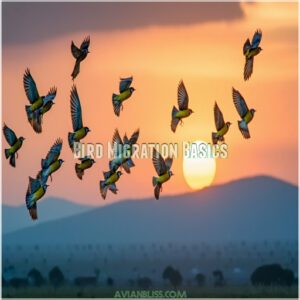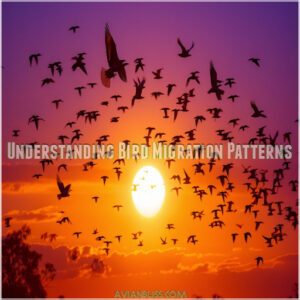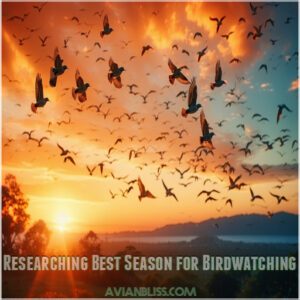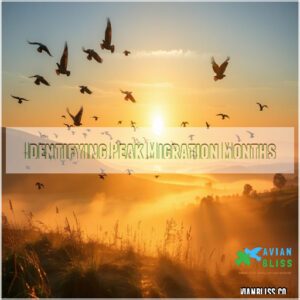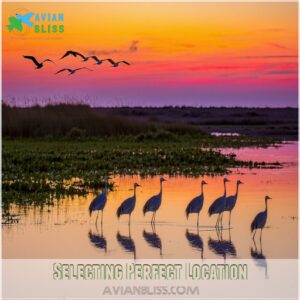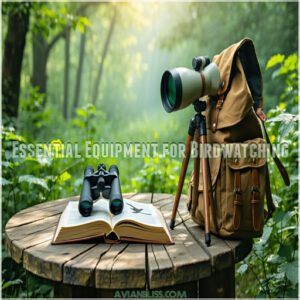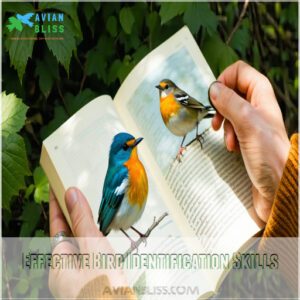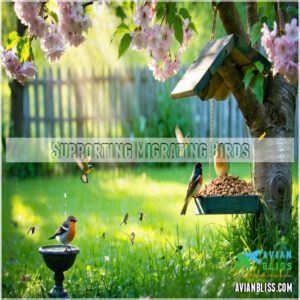This site is supported by our readers. We may earn a commission, at no cost to you, if you purchase through links.
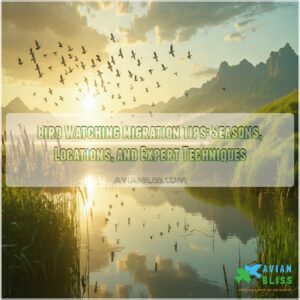
To catch nature’s greatest show, time your bird watching trips using BirdCast forecasts and follow the sun – birds migrate earlier in the West and later in the Northeast.
Make your backyard a five-star rest stop by offering high-energy foods and clean water sources.
Remember to dim outdoor lights during peak migration – you’ll be amazed how many species you’ll spot when you create a bird-friendly pit stop.
The secret to spotting rare migrants lies in understanding their celestial navigation techniques.
Table Of Contents
- Key Takeaways
- Bird Migration Basics
- Choosing Best Season
- Selecting Perfect Location
- Bird Watching Techniques
- Supporting Migrating Birds
- Frequently Asked Questions (FAQs)
- When is the best time to Birdwatch during migration season?
- How do you prepare for a bird migration?
- Can you pick up birdwatching easily?
- How do you plan a birdwatching trip?
- What are bird migration patterns?
- How do you etiquette birdwatching?
- What is the best time of day to see birds migrating?
- What triggers birds to get ready for migration?
- How do birds avoid getting lost when migrating?
- How do birds know where to go during migration?
- Conclusion
Key Takeaways
- You’ll catch peak migration action between March-May for spring and August-October for fall, with birds traveling earlier in the West and later in the Northeast according to BirdCast forecasts.
- You’ll maximize your birdwatching success by visiting wetlands, mountain passes, and coastal areas during dawn or dusk, and by wearing earth-toned clothes while moving slowly and quietly.
- You can support migrating birds by creating rest stops with high-energy foods, clean water sources, and native plants in your yard, while reducing light pollution by using amber lights and window decals.
- You’ll need quality 8x or 10x binoculars, a field guide, and weather tracking apps to identify birds effectively – focus on distinctive features like size, shape, beak structure, and wing patterns.
Bird Migration Basics
Bird migration is the seasonal journey birds take to find food, suitable climates, and safe breeding grounds.
It’s a fascinating process driven by changes in daylight, temperature, and the availability of resources.
What is Bird Migration
Bird migration is nature’s ultimate road trip, driven by seasonal changes and survival instincts.
Birds follow precise migration patterns, tracing flight routes using the sun, stars, and even Earth’s magnetic field.
These journeys, tied to bird migration seasons, help them find food and safe habitats.
Scientists study bird behavior migration patterns to understand the nuances of these incredible feats of bird behavior and adaptation across ever-changing landscapes, which is a fascinating dance.
Why Do Birds Migrate
Ever wonder why birds take on such epic journeys.
It’s all about survival. Migration behaviors are driven by food sources, bird instincts, and even genetic predisposition.
Changing seasons and climate push birds to follow specific migration patterns and routes.
They seek better resources, escape harsh weather, and find breeding grounds, showcasing nature’s perfect balance of timing and purpose, which is driven by migration patterns.
When Does Migration Occur
Seasonal changes drive migration timing, with birds responding to shifts in day length, weather patterns, and food availability.
Spring bird migration kicks off between March and May, while fall bird migration peaks from August to October.
Some species follow precise migration routes, while others adapt to conditions.
Watching a bird migration forecast can help you plan for these incredible seasonal journeys.
Choosing Best Season
Timing is everything in the context of birdwatching, and choosing the right season lets you witness the most spectacular migrations.
By understanding migration patterns and peak months, you’ll maximize your chances of spotting diverse species in action.
Understanding Bird Migration Patterns
Understanding bird migration patterns means grasping how seasonal cues like day length and temperature guide birds along precise migration routes.
Some species cross continents, while others stick closer to home.
Spring bird migration often feels like nature’s grand opening, while fall bird migration showcases incredible flight patterns.
The U.S. Fish & Wildlife Service supports migratory bird conservation through various programs and initiatives.
Birds navigate using stars, landmarks, and even Earth’s magnetic field—nature’s ultimate GPS.
Researching Best Season for Birdwatching
Right now, you’re probably wondering when to grab those binoculars for the perfect seasonal birdwatching adventure.
Weather plays a significant role in determining habitat conditions and bird behavior.
To maximize your chances of spotting diverse species, consider seasonal birdwatching patterns, especially during spring and fall migrations.
- Use migration calendars and tracking apps to plan your outings around seasonal bird patterns
- Watch for moderate temperatures and gentle winds under 25mph for ideal viewing conditions
- Follow local birding groups that share real-time updates about climate effects on migration
Identifying Peak Migration Months
Now that you’ve picked your season, let’s pinpoint the best months to catch birds on the move.
In North America, you’ll spot spring migration from March to June as birds head north, while fall migration runs August to November.
Peak action hits when 50% of nocturnal birds pass through – earlier out West, later in the Northeast.
Pro tip: Use BirdCast’s forecasts to track migration in your area.
Selecting Perfect Location
You’ll find prime birdwatching spots near wetlands, mountain passes, and coastal areas where migrating birds naturally gather during their seasonal journeys.
Once you’ve picked your location, you can spot diverse species like Arctic Terns and Sandhill Cranes as they follow their ancient pathways along these natural migration highways.
Identifying Local Birding Hotspots
Nature’s best birding hotspots are closer than you think.
You’ll find migration hotspots everywhere from bustling urban parks to peaceful coastal spots.
Local species thrive in diverse bird habitats that fit their unique patterns.
For those near Virginia, exploring Virginia birding hotspots offers diverse options from the coast to the mountains.
Check out eBird’s latest hotspot maps to discover where fellow birders spotted their favorites.
- Grays Harbor National Wildlife Refuge offers prime viewing of shorebirds during migration
- Urban birding opportunities flourish in city parks and green spaces
- Coastal wetlands like Sweetwater attract hundreds of species
- Your own backyard can become a local hotspot with the right setup
Researching Birding Trails and Reserves
Beyond local hotspots, you’ll find a treasure trove of birding opportunities across protected Conservation Areas.
The New York State Birding Trail now connects over 325 locations, offering world-class bird watching tours and Wildlife Sanctuaries.
Many enthusiasts rely on birding trails reserves to plan their excursions.
Here’s your guide to top birding trails and reserves:
| Trail Name | Features | Best For |
|---|---|---|
| NYS Birding Trail | 325+ locations statewide | All skill levels |
| IBA Network | Protected bird habitats | Rare species spotting |
| Wildlife Refuges | Reserve Management areas | Migration routes |
Considering Habitat Types
Several distinct habitats shape the grand theater of bird migration patterns.
You’ll discover unique species and behaviors in each environment along bird migration routes.
- Wetland conservation areas attract diverse waterfowl and wading birds, offering prime viewing spots
- Forest ecology zones shelter songbirds in dense canopies and bustling forest floors
- Coastal management areas provide critical rest stops for shorebirds
- Grassland preservation sites support roughly 20% of bird species
Each habitat type tells its own migration story.
Bird Watching Techniques
You’ll discover how your keen observation skills and the right equipment can transform you into an expert bird watcher during migration season.
With proper techniques for staying quiet and using essential tools like binoculars and field guides, you’ll spot more birds than you ever thought possible.
Essential Equipment for Birdwatching
You’ll want to start with quality bird watching binoculars – aim for 8x or 10x magnification for the sweet spot between detail and stability.
A spotting scope, like the Zeiss Victory Harpia, lets you catch those far-off beauties.
For a wider selection, explore these bird watching binoculars online.
Don’t forget your tripod stabilization for steady views, and pack a field guide, and if you’re into photography, bring camera lenses that match your spotting scope’s magnification.
Effective Bird Identification Skills
Now that you’ve got your gear, let’s sharpen those bird identification skills.
Start with a reliable bird identification guide and focus on the basics: size, shape, and behavior patterns.
Look for distinctive features like beak shapes, wing patterns, and plumage colors.
Train your eye to notice feather analysis details – a red crown here, a striped wing there.
Think of it like solving a puzzle, each clue bringing you closer to naming that mystery bird.
Minimizing Visual and Auditory Impact
Moving up on birds with care can make or break your birdwatching experience.
You’ll want to blend into the background while staying quiet and still.
Think of yourself as part nature photographer, part ninja.
- Wear earth-toned clothes that rustle less in the wind
- Keep your movements slow and deliberate, like a cat stalking
- Stay downwind so birds can’t catch your scent
- Use natural cover like trees and shrubs
- Keep your voice to whispers, if you need to talk at all
When you’ve mastered these stealth methods, you’ll get closer to birds without disturbing their natural behavior – and that’s when the real magic happens.
Supporting Migrating Birds
You’ll discover practical ways to help migrating birds through simple actions like offering high-quality bird food and turning off unnecessary lights at night.
You can make a real difference in their incredible journeys by creating safe rest stops in your yard with native plants that provide natural food sources and shelter.
Providing Food and Water Sources
The right food sources can make your backyard a five-star rest stop for migrating birds.
You’ll need strategic feeding strategies that match their high-energy needs during migration.
Specialty bird feeders aid migration and can provide essential support.
Well-placed bird feeders and clean water sources give these feathered travelers the fuel they need for their long journeys.
| Feeding Strategy | Implementation Tips |
|---|---|
| Native Plants | Plant local species that attract insects |
| Water Quality | Clean birdbaths daily with hot, soapy water |
| Seed Selection | Choose high-energy, protein-rich wild bird food |
| Feeder Location | Place in quiet, sheltered spots |
| Natural Foods | Preserve insect habitats in your yard |
Reducing Light Pollution and Collisions
During bird migration season, light pollution from buildings poses a serious threat to our feathered friends.
You can make a real difference by implementing smart lighting strategies:
- Switch to amber or orange lights with longer wavelengths
- Install motion sensors and timers for exterior lighting
- Apply window decals or non-toxic tempera paint in patterns
These bird-friendly lighting choices help prevent window collisions and support safe migration paths through urban areas.
Participating in Conservation Efforts
Taking action for wildlife preservation starts at home!
Join the Great Backyard Bird Count this February to support bird conservation while having fun.
You’ll contribute to essential citizen science projects that shape habitat conservation strategies.
Understanding bird conservation efforts is essential for making informed decisions about supporting migrating birds.
Here’s how you can make an impact:
| Conservation Action | Benefits to Birds | Time Investment |
|---|---|---|
| Count backyard birds | Direct data collection | 15 mins/day |
| Create eco-friendly spaces | Habitat restoration | 2 hrs/month |
| Support birdfriendly policies | Long-term protection | 1 hr/month |
Frequently Asked Questions (FAQs)
When is the best time to Birdwatch during migration season?
You’ll catch nature’s best show at dawn’s first light, when migrating birds are most active and vocal. For a different lineup, try dusk when nocturnal species start their evening routines.
How do you prepare for a bird migration?
Pack your binoculars, field guide, and weather app.
Check BirdCast for migration forecasts, locate prime viewing spots, and plan your visits during dawn or dusk.
You’ll need comfortable clothes and patience.
Can you pick up birdwatching easily?
You’ll find it surprisingly easy to start birdwatching.
All you need are basic binoculars and a field guide.
Once you learn common local species, you’ll quickly develop an eye for spotting unique birds.
How do you plan a birdwatching trip?
Research migration patterns and local hotspots online, check weather forecasts, and pick dawn or dusk times.
You’ll need binoculars, a field guide, and comfy clothes.
Scout locations beforehand for the best views.
What are bird migration patterns?
Birds typically migrate north in spring and south in fall.
You’ll notice them flying at night to avoid predators, using Earth’s magnetic field, stars, and landmarks to navigate their incredible journeys.
How do you etiquette birdwatching?
Like a whisper in nature’s concert, you’ll want to tread softly.
Stay on marked trails, keep your distance, and never disturb nests.
Your binoculars are your front-row ticket to nature’s show.
What is the best time of day to see birds migrating?
You’ll spot the most migrating birds during dawn and early morning hours, as well as at dusk.
Don’t skip nighttime watching – many species prefer traveling after dark when conditions are calmer.
What triggers birds to get ready for migration?
You’ll notice your feathered friends preparing for their journey when daylight hours shift, temperatures drop, and food sources change.
Their internal clock and genetic programming also play key roles in migration timing.
How do birds avoid getting lost when migrating?
Nature’s equipped these skilled navigators with multiple tools: they’ll use the sun, stars, Earth’s magnetic field, and familiar landmarks as their GPS.
You’ll even find some relying on their sense of smell!
How do birds know where to go during migration?
Birds rely on multiple navigation tools during migration – they’ll use the sun’s position, star patterns, Earth’s magnetic field, and even familiar landmarks.
They’re born with these incredible abilities to guide their journeys, utilizing tools like the Earth’s magnetic field.
Conclusion
You’re now equipped with essential bird watching migration tips to transform your backyard into a spectacular avian paradise.
Whether you’re tracking spring arrivals or fall departures, understanding migration patterns helps you maximize every bird watching moment.
Remember, success isn’t just about spotting birds—it’s about creating safe havens for our feathered friends.
By following these guidelines and staying patient, you’ll develop a deeper connection with nature’s most magnificent seasonal spectacle.
- https://www.allaboutbirds.org/news/the-basics-how-why-and-where-of-bird-migration/
- https://www.lyricbirdfood.com/birding-hub/migration/6-tips-for-bird-watching-during-fall-migration/
- https://birdcast.info/
- https://rachelcarsoncouncil.org/awe-mystery-bird-migration/
- https://www.perkypet.com/advice/bird-watching/bird-migration-facts/timing

